Bradford Pear Pruning
I talked to the guy who did this pruning. He said if everyone did pears like this there would be no problems. He said it has to be repeated every few years. What do you think?
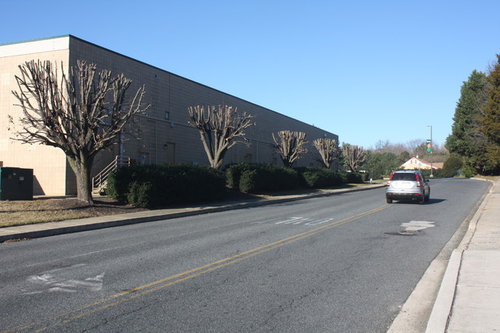
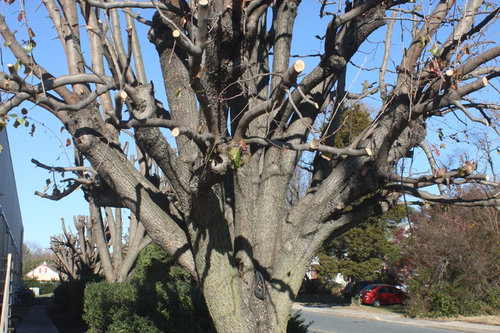
Commentaires (44)
ken_adrian Adrian MI cold Z5
il y a 7 ansHe said it has to be repeated every few years.
==>>> yes.. and he will gladly come back and recharge them every time ... lol
i presume brandon missed his mark on a joke.. a good basal cut at ground level.. and some grinding.. would solve the issue .. lol ..
how do you figure this pruning.. overcomes its invasive tendencies ...???
kenkentrees12
il y a 7 ansThat's very common around here, especially in office parks and shopping centers. In summer the trees look like green meatballs on a stick. Not much bloom in spring as the wood doesn't get old enough to produce lots of blooming spurs. Fall color isn't all that great because of the rapid growth. I guess they're going for the 'European look' LOL.
Huggorm
il y a 7 ansI guess they're going for the 'European look' LOL.
Maybe, at least that's a common form of pruning over here. Nice, dense meatballs in summer, a complete mess when the leaves fall of.
hortster
il y a 7 ansFor Bradford pear I agree with Ken's "one cut prune" assertion, only would add a thorough Tordon dapping of the stump as well.
Mike McGarvey
il y a 7 ansHe's in the wrong trade. He should be a butcher. He's a natural and it would be a good fit.
Les Arbres Tree Service & Fine Gardening
il y a 7 ansWell that is a false attempt of pollarding...luckily that kind of work is on a Bradford Pear, they grow like weeds and are extremely brittle. Hopefully those get removed and a better plant (aesthetically and health wise) is planted. Oh, and hopefully a licensed professional can preform the pruning for now on. That kind of work gives those in our industry a bad name!
Toronado3800 Zone 6 St Louis
il y a 7 ansBy eliminating most of the flowers I suppose you fix the urine like
odor and slow their invasive tendencies.... Plus if they are 5 foot
stubs they might not blow apart as quickly.Seems to be more regular work than I am willing to pay for.Logan L Johnson
il y a 7 ansHere I would say around 70% of homeowners have their trees topped. Regardless of type. I have seen crepe myrtles (most common), bradford pear (2nd most common), sugar maple, norway maple, red maple, japanese maple 'bloodgood', mimosa, white oak, willow oak, tulip tree, eastern redbud, loblolly pine, and even norway spruce.
laceyvail 6A, WV
il y a 7 ansThat's exactly how they're "pruned" (mutilated) on the main street of the county seat near me. Absolutely grotesque.
Mike McGarvey
il y a 7 ansA lot of people are happy with that type of 'pruning' and can justify it by the fact it was 'professionally' done. Plus, they see it all over the neighborhood. It's like the blind leading the blind. This is what we teach NOT to do.
Logan L Johnson
il y a 7 ansDernière modification :il y a 7 ansThis spring I distributed pamphlets to homes I saw with topped trees. Many people were truly concerned, because they thought it was the correct way to prune, and that the new growth was a sign of life. I explained how to fix it (choosing a single leader) and allowing it to grow in place of the former watersprouts. I don't discourage topping of bradford pear, because I hate this tree.
wisconsitom
il y a 7 ansWell Logan, we have a point of agreement! And as far as your main point-that folks thought this was "right"...that is exactly the scenario I often cite to explain why shrubs look so very awful in this country. Old Uncle Joe across the street got his hedge trimmers out-everyone knows you have to shear all your stuff in the fall, right!.....so monkey see-monkey do, and now we have all shrubs treated as sheered specimens even though they are of a species utterly unsuited for such treatment. This is the very explanation of how shrub work is so very poor in most cases. People really haven't a clue how to handle shrubs. But I respect your efforts at education. It ain't easy! People tend to think they know about plants, just because they've been seeing them all their lives. But studies have shown that people are essentially plant-blind. A botany professor tells the story of how on the first day of class-Botany 101-he put a photo up for the kids to view, and simply asked them to write down what they saw in the photo. This was a rainforest scene. There was one bird in the picture, and lots and lots of vegetation. So, what did the kids see in that photo? A bird, nothing else. None of these botany students noticed that there were lots of plants in the photo.
Logan L Johnson
il y a 7 ansI do shear shrubs, but I use more "topiary" techniques and typically only shear boxwood, loropetalum (depends on cultivar), forsythia, and abelia (depending on cultivar). I just had to explain to the people who moved in down the street why you don't shear evergreen azaleas or rhododendrons, and why tree topping is a bad technique (many of the trees were topped by the previous homeowner) and I took lots of sheared azaleas and a rhododendron which I happily performed rejuvenation pruning on the get back the natural look.
shaxhome (Frog Rock, Australia 9b)
il y a 7 ansDernière modification :il y a 7 ansThe Japanese seem to be able to shear their azaleas with great success. Not necessarily to my personal taste, but I do admire their skill and artistry. Wouldn't like to have to "rejuvenate" this lot...
(click on pic to enlarge)
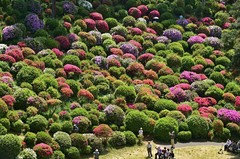
Logan L Johnson
il y a 7 ansIt works great for 5 years or so, then they start getting holes in them. After that they just die completely.
Mike McGarvey
il y a 7 ansJudging by that photograph every one is a lot older than 5 years and I don't see a holes all over....if any. Click on the photograph, Logan.
Logan L Johnson
il y a 7 ansI did click on the photo. You are correct, however, could you explain how they achieved this without killing them?
wisconsitom
il y a 7 ansWhile the photo is impressive, I suspect they'd look equally good-just different-if all that shearing had not been done. Whatever....it's their garden!
shaxhome (Frog Rock, Australia 9b)
il y a 7 ansI'm totally with you on that, Tom, love the natural look. But I'm sure you've seen many weird and wonderful examples of this Japanese art form...and they sure know how to prune!

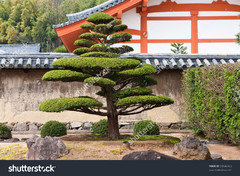
rhizo_1 (North AL) zone 7
il y a 7 ansLogan, shearing doesn't kill shrubs. Where on earth did you get that idea?
I'd be very interested in seeing your pamphlet and I'm certain that others are, as well. How about taking a picture and letting us see it?
Logan L Johnson
il y a 7 ansEvery azalea that I attempted to shear died a slow and miserable death. I will see if I can dig up the pamphlet file, I have re-imaged the computers since then but hopefully it will still be on the server.
gardengal48 (PNW Z8/9)
il y a 7 ansWhile all those plants may look sheared, I doubt they are. Japanese pruning techniques tend to treat each branch individually and shearing tools - especially power tools - are generally NOT in their repertoire!! Overall, the Japanese tend to be master pruners and spend years perfecting their craft and hours getting each plant just right.
Logan L Johnson
il y a 7 ansI don't use power tools. Read the article that I wrote about shearing:
==>>>https://caldwellhg.blogspot.com/2016/11/how-to-properly-shear-shrubs.html
But this just doesn't work with azaleas.
wisconsitom
il y a 7 ansYes, much respect for the Japanese artists. Grandma gave me a real nice book about Japanese gardening when I was a young'n and I've always loved the look. Those latter pics are fantastic, shax!
hairmetal4ever
il y a 7 ansDernière modification :il y a 7 ansI prefer one cut at ground level on Bradfords.
Embothrium
il y a 7 ansThose azaleas didn't grow as balls on their own. And evergreen azaleas and other low evergreen shrubs are often sheared to represent rocks in Japanese gardens.
Whatever tools they are using to do it.
rockgriep
il y a 7 ansEven if you consider Bradford's "bottom of the barrel" trees, they don't deserve to be topped... no tree does. Explained to me why you would purposely harm your tree and weaken it by pruning it that way? Especially topped trees next to houses or buildings or in public areas.
Many insurance companies will NOT cover any damage done to property by trees that are in a state of neglect. The homeowner/tree owner may be responsible or any costs from any damage these trees may have caused. Most insurance companies consider "topping" trees to fall under neglect. Topping also encourages heart rot in many species of trees.
If you plan to top or pollard trees, do them this one small favor, clean your tools after each cut and don't treat the cuts, instead, let them heal naturally. Sealing cuts can seal in pathogens, bacteria/fungi and other damaging pests, further harming the tree.
They could have performed some "reduction" pruning on those Bradford's instead of destroying them with "topping". The guy who pruned those trees may have been licensed, but he's no arborist!
tlbean2004
il y a 7 ansThat kind of pruning on bradford pears is done in different areas around where i live at. It lets them live longer by not splitting in half like they normally would it left to grow on their own with no intervention.
Mike McGarvey
il y a 7 ansLogan, the holes develop when the azalea is kept at the same size year after year, or most likely, every other year, and the guy doing the shearing is playing catchup.
Embothrium, I too have seen pictures of where the Japanese have trimmed azaleas to compliment a rock outcropping by looking like an extension of it. Very cool! Best done on a slope.
Logan L Johnson
il y a 7 ansI understand what you are saying, but I don't play "catch up". Unless I am bleeding out and dying, I walk the yard once a week and perform any necessary gardening tasks (in the winter, sometimes less because I hate the cold).
Conor MacDonald, Rhode Island, z6b
il y a 7 ansWe have dozens of large old pears downtown Providence, RI, I suspect they are Bradford (they must be 30 years old) and they are absolutely some of the most graceful trees I've ever seen--clearly they've lost limbs but the asymmetry that results--plus the leaning toward the sunlight--is really stunning. The perfect symmetry is fitting for a corporate campus, but in quirky downtown some originality and exuberance seems fitting! I'm sure they are living on borrowed time, but they are not (as far as I can tell) spreading here. They must be well tended--there are no branches-on-cars-and-people disasters that i know of. At some point, the joy of a beautiful living thing must outweigh the detractions, no? I'll have to take pictures and share in a few months when they start to bloom. They are truly worth the maintenance in climates where they don't become invasive.
Logan L Johnson
il y a 7 ansThere is no joy to such a nuisance. Just walk up to one of them blooming in the spring..... get a nose full of that stench and you won't think of them as "graceful"........ maybe "graceful" as the smell of rotting fish (literally).
Toronado3800 Zone 6 St Louis
il y a 7 ansHello Conor,
http://delawareinvasives.net/blog1/wp-content/uploads/2016/02/BP.pdf
You can download the PDF if you want, but it basically complains Bradfords are invasive in Delaware. I can find no such declaration for Jersey but I don't recall a climatic difference so I bet it is.
They do have a decent bloom time. At one of our locations the landlord planted 8. They are malodorous to say the least in that quantity. A couple have blown apart. The ones between the buildings have not. St Peters MO is a floodplain disaster waiting to happen of hastily constructed steel garages/buildings and suffers heavily of a lack of diversity in landscape plants supplied by seemingly just Walmart and Lowes so our landlord is up to specs there.
Conor MacDonald, Rhode Island, z6b
il y a 7 ansPerhaps they are not Bradford--these don't smell strongly, I've spent quite a lot of time underneath them in full bloom; they clearly split but don't ever "blow apart" like the images you see online--the original planting seems to be largely intact. I'm no botanist--perhaps the trees in downtown Providence are contributing to invasive populations in Delaware--birds fly far!--and they should be removed. Having a few street trees that are not blandly uniform and contribute to the city in an almost sculptural way is really nice, even if you have to pick up a limb every ten years. It just seems worth appreciating them while they are there. Which reminds me, I should document them before they all come down!
Logan L Johnson
il y a 7 ansIt may be 'Holmford' which is considered the "new" or "improved" bradford.
Conor MacDonald, Rhode Island, z6b
il y a 7 ans
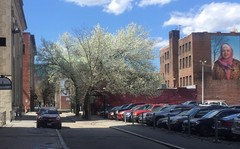
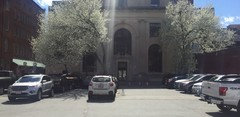
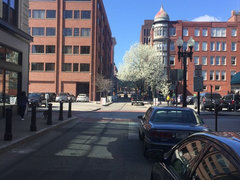
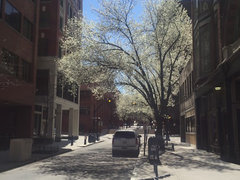
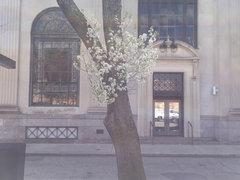
I promised to post pics before they cut them down... I missed a few. These are so gorgeous to me!
Logan L Johnson
il y a 7 ansConor, I have seen callery pear with that form before. I know that they are bradford, but they really don't look like it.
Utilisateur Houzz - 113070711
il y a 2 ansfunny reading all these "experts" opinions on Bradfords. I studied forestry in college and pruning trees back (even at top) is acceptable to prolong life and/or symmetry. Are Bradfords perfect? No.....but for many people that plant them they are a fast growing beautiful tree that meets a need.
Les Arbres Tree Service & Fine Gardening
il y a 2 ansInteresting the difference between people who “studied” pruning and those who are licensed and have practical, hands on experience. Sure, topping forces mass suckers and regenerative growth but Bradfords are already extremely fast growing and sucker out like crazy. They fill a need because they are inexpensive, fast growing trees which flower and most people who recommend them don’t know the difference between a bad plant and a plant of long term value. Bradfords are so fast growing that their internal cell structure cannot interlock fully (which I’m sure you know from your collegiate studies). The fact that they grow so fast makes them extremely tall and dense and does not fare well with allowing air to flow through the tree or sun penetration (which are essentials for plant health). That weight causes excess “sail” and the tree, as all Bradfords do, fails. Also, topping may be acceptable in a textbook and to those who don’t have a discerning eye, but health wise and aesthetically, it’s terrible. That’s coming from a multi licensed arborist who deals with these plants for a living.

Rechargez la page pour ne plus voir cette annonce spécifique

brandon7 TN_zone7